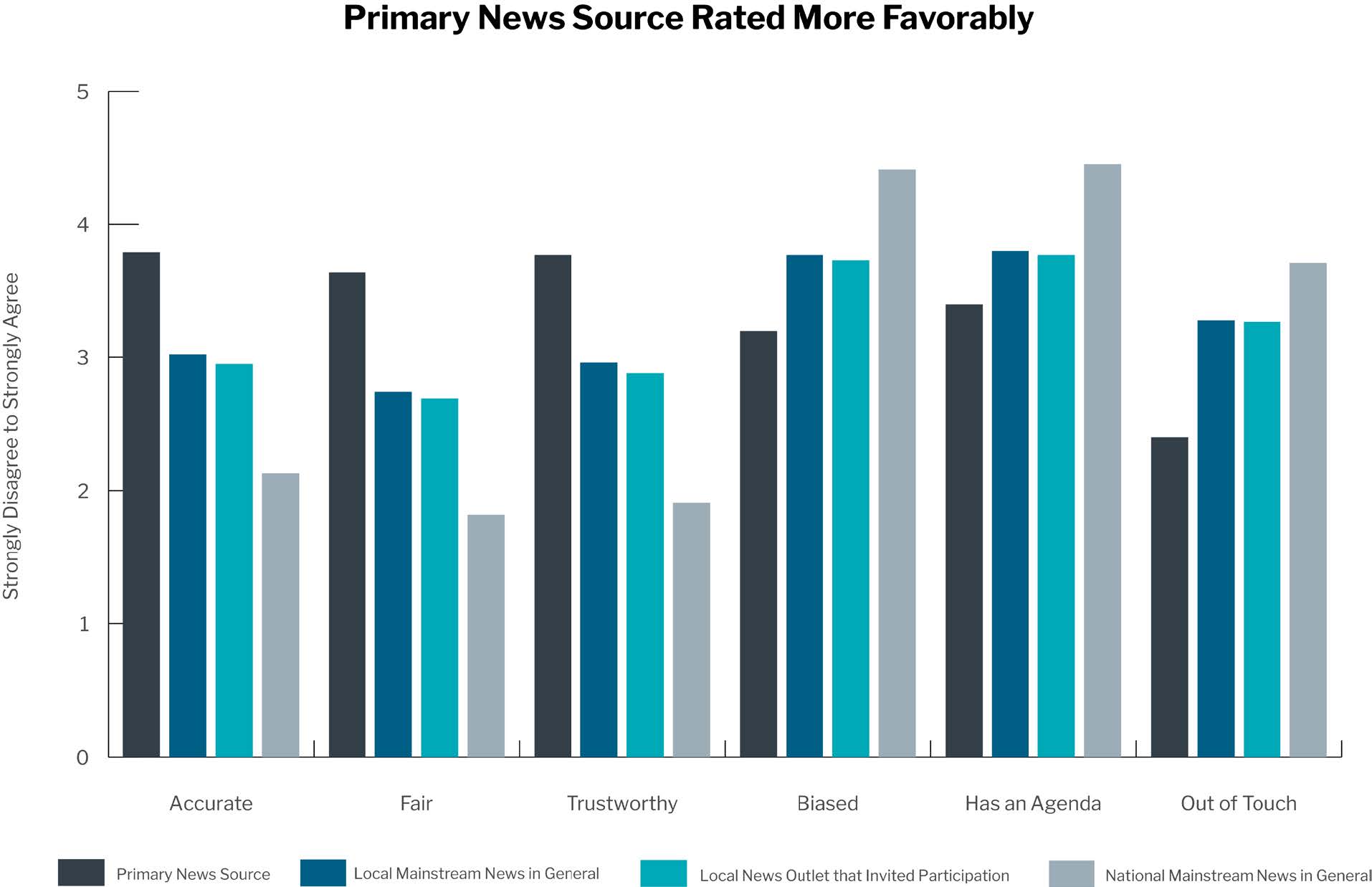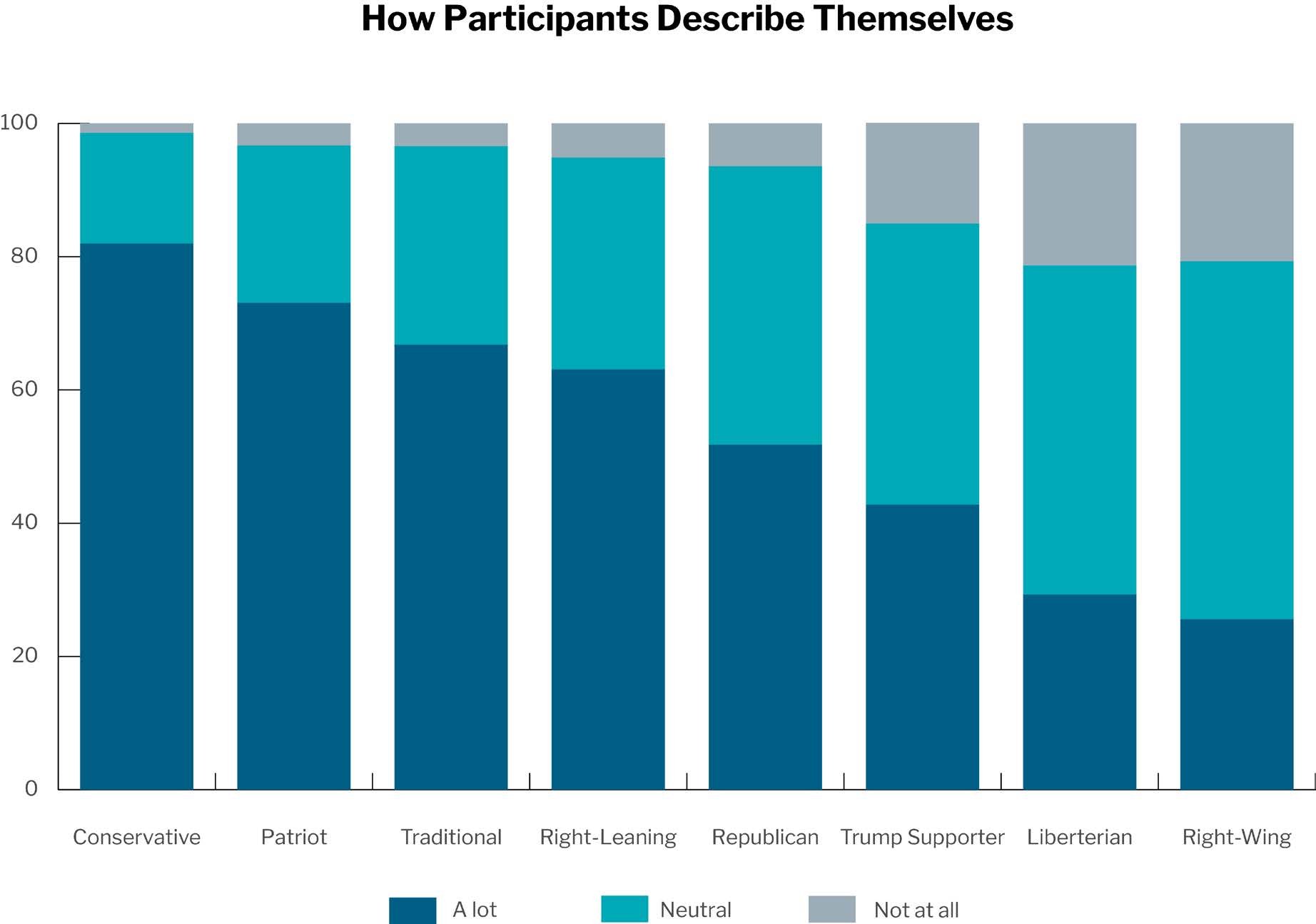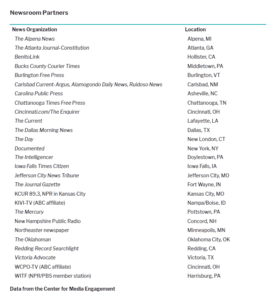
SUMMARY
The Center for Media Engagement partnered with Trusting News and 27 local newsrooms to find out how news organizations can help bridge the divide between the media and American conservative and right-leaning audiences. Interviews with people who consider themselves conservative showed that they often felt portrayed stereotypically in the news and that they believed newsrooms need to address perceptions of bias against conservatives and those with right-leaning viewpoints.
The discussions revealed six approaches journalists can take to better connect with their conservative and right-leaning audiences:
- Build relationships with people who have conservative and right-leaning viewpoints in your community and listen to them.
- Include a variety of voices from people with conservative and right-leaning views in stories. Journalists should be cautious of using “conservative” or other terms as catch-all labels for people who may have very different beliefs.
- Consider diversity of political beliefs and backgrounds when hiring for the newsroom.
- Focus on story facts, not interpretation.
- Correct mistakes promptly to demonstrate trustworthiness.
- Don’t criticize only one side of an issue.
THE PROBLEM
Many Americans do not trust the news media.1 This distrust is particularly pronounced among those who consider themselves politically conservative or right-leaning, and media distrust among these groups is growing.2 This creates a challenge for newsrooms and for democracy, not just for political coverage but for any coverage that aims to reflect the lives and values of its varied audiences. In this project, the Center for Media Engagement teamed up with Trusting News and 27 local newsroom partners to ask American conservatives how news organizations could better cover them to help bridge the divide between them and the media.
KEY FINDINGS
- Concerns about whether national news is believable or trustworthy: Participants perceived local news outlets much more favorably than national news outlets, and many described local news as playing a vital role in their lives. CNN received the most mentions as an untrustworthy source, while FOX News received the most mentions for trustworthiness. For local news, trust was higher for local TV station affiliates than for local newspapers. Many participants were troubled when local news seemed overly reliant on national news sources, especially from wire services like The Associated Press that they perceived as lacking balance in stories.
- Concerns about portrayals of conservative and right-leaning Americans: Many participants expressed concerns that the news media stereotype conservatives and those with right-leaning views as having the same opinions about race, Donald Trump, and other issues, or by depicting all conservatives as extremists. They urged journalists to provide a more nuanced view of people with conservative and right-leaning beliefs and opinions and to include a variety of these voices in stories.
- Perceptions of bias in news coverage: Perceptions of bias in the news was one of the most commonly raised concerns. Participants stressed that bias is a complicated notion that includes the stories journalists cover (or don’t cover), how journalists ask questions, and what they inferred were journalists’ attitudes toward the issues in their stories.
IMPLICATIONS FOR NEWSROOMS
Our interviews reveal the following six approaches journalists can take to help bridge the divide between the media and conservative and right-leaning audiences:
- Build relationships with people who have conservative and right-leaning viewpoints in your community and listen to them.
- Include a variety of voices from people with conservative and right-leaning views in Journalists should be cautious of using “conservative” or other terms as catch-all labels for people who may have very different beliefs.
- Consider diversity of political beliefs and backgrounds when hiring for the newsroom.
- Focus on story facts, not interpretation.
- Correct mistakes promptly to demonstrate trustworthiness.
- Don’t criticize only one side of an issue.
FULL FINDINGS
The Center for Media Engagement surveyed 3,467 Americans who consider themselves conservative or right-leaning, and our newsroom partners interviewed 91 of them at length. Although we acknowledge “conservative” should not be used as a catch-all term, all of our participants selected either “conservative” (74.9%) or “very conservative” (25.1%) to describe themselves. Interview participants are described using pseudonyms they chose or were given. Findings focus first on the problems participants identified and then the solutions they suggested.
Problems
Concerns about Whether National News is Believable or Trustworthy
Overall, participants rated local news more favorably than national news on a variety of metrics, including “believability” and “trustworthiness.” Many interview participants noted that local news media cover news that is important to them and that they had greater concerns regarding national news media. “I love the way the local news is reported,” explained Emily, 71, who was interviewed by The Alpena News in Michigan. “… I don’t know how I could live without the local stories.”
Paul, 45, who was interviewed by KIVI-TV in Idaho, also shared an appreciation for local media: “Local does a lot better job of getting conservatives right just because … at least some of the journalists actually are conservative.”
Multiple participants raised concerns that local news seems to be overly reliant on national news, especially from wire services like The Associated Press. “There will be stories by the AP that were, I mean, literally, should have been on the editorial page,” said Richard, 55, who was interviewed by the Bucks County Courier Times in Pennsylvania. “… I want a neutral point of view.”
Emily, 71, who was interviewed by The Alpena News in Michigan, shared a similar point: “What you read from the AP is not balanced….. I don’t see any balance at all with AP. It’s just Trump bad, bad, bad. Biden good, good, good.”
Carol, 70, who was interviewed by The Atlanta Journal-Constitution in Georgia, said wire stories from AP, The New York Times, and The Washington Post are “rife with, with their own opinions and their agenda.”
Believability
Participants on average had low ratings for the believability of mainstream journalism, although they were significantly more likely to believe local mainstream journalism than national mainstream journalism.3 Mainstream news was defined for participants as “general interest news that you find online, in a newspaper, on TV, or on the radio.”

Perceptions of News Sources
Participants rated their thoughts regarding four news outlet categories:
- The news outlet that they use the most – either national or local. They wrote in the name of this news outlet.
- The local news outlet that invited them to participate in the study.
- Mainstream local news in general.
- Mainstream national news in general.
They rated the news source they used the most as significantly more “accurate,” “fair,” and “trustworthy” than all three other news categories. They also gave significantly lower ratings to the news source they used the most for “has an agenda” than the other three news categories.
They rated national mainstream news as more “biased” and “out of touch” than the other three categories. Participants rated the local news outlet that invited them to participate and local mainstream news in general as equally “biased” and “out of touch.” 4

Trusted and Distrusted News Outlets
When participants were prompted to write in the names of news outlets they found trustworthy for national news, the first outlet mentioned by the most people was FOX News (28.7%), followed by none (13.4%), The Wall Street Journal (9.0%), Newsmax (6.8%), and One America News Network [OANN] (4.0%). When asked to name news outlets they found untrustworthy for national news, the first outlet mentioned by the most participants was CNN (43.0%), followed by ABC News (9.8%), MSNBC (8.7%), all media (6.8%), and FOX News (5.5%).5
For local news, 41.4% of participants reported they trusted a local TV station affiliate the most, which is 13.7 percentage points more than those who distrusted a local TV station affiliate the most (27.7%). A total of 36.6% of participants distrusted a local newspaper the most, which is 11.7 percentage points more than those who trusted a local newspaper the most (24.9%). These findings suggest that our participants overall have greater trust in local TV news than local newspapers.
Concerns about Portrayals of Conservatives
Multiple interview participants said they felt that media portrayals of conservatives seem to rely on narrow or extreme stereotypes, which they felt assume conservatives are racist, uneducated, unkind, or only care about money. “There’s a lot of different kinds of conservatives, and they just lump them all together as the right-wing extremists,” explained Monica, 66, who was interviewed by the Iowa Falls Times Citizen in Iowa.
As Jermal, 39, who was interviewed by the Chattanooga Times Free Press in Tennessee, put it: “I can be pro-choice and want a gun. Right? And I can be pro capital punishment and support gay marriage and transgender rights. So we’re defined by these big talking points that … don’t necessarily define us on an individual basis.” Jermal also noted that the news media seems to label all political conservatives “as conservative Christians. Not all of us are.”
Greg, 68, who was interviewed by The Alpena News in Michigan, expressed a similar sentiment, which many participants seemed to share: “I guess just because I’m a conservative white guy, it seems like the news seems to automatically kind of lump me in as, you know, white privilege and racist, you know, which I’m not.”
Participants expressed that even the media’s efforts to understand conservatives often fell short. Bill, 57, who was interviewed by the Bucks County Courier Times in Pennsylvania, explained that stories about Trump supporters in the 2016 election “were almost done in this tone of the explorer finding a lost tribe in the woods some place. You know, just like, oh, look at this culture over here, they are so different from everything we know.”
Fear of Expressing Views
This narrow depiction of people with conservative or right-leaning views made some participants afraid to express their views. “I think they get wrong that a lot of conservative people are not … what you think of, you know, with the big truck, with the flag flying out the back and then you know the MAGA hats and all that stuff,” said Dave, 64, who was interviewed by the Chattanooga Times Free Press in Tennessee. “There’s a, a very large number of people that have very conservative views that are not vocal about things because I think with the current atmosphere a lot of people are kind of afraid to … be vocal about them because of the backlash that … they could receive.”
Perceptions of Bias in News
Many participants raised concerns about bias in the news. Of the 3,190 people who answered an open-ended survey question about what they “wish journalists knew about how people with your political beliefs feel about the news,” 808 (25.3%) used the word bias.
Participants’ answers to this question showed that they perceive bias when journalists seem to be interpreting the news or its implications, in the selection of stories that are covered (or not covered), and in how journalists phrase questions. “When your question is phrased as an accusation, or as an assumption of which way the answer should go, you reveal your bias,” explained one survey participant (survey participants were anonymous).
Another survey participant attributed bias to the fact that major national media are located in big cities. “I wish national media had a better grasp on the daily needs of our more rural southern and Midwest cities,” the person wrote. “I find a ‘disrespect’ from media who feel we are uneducated and ‘unwoke’ for not adopting a more liberal agenda.”
Interview participants shared similar concerns. “The spin … always seems to be the conservative view is the negative view the good people are fighting against,” said Holly, 65, who was interviewed by the Burlington Free Press in Vermont.
Ralph, 27, who was interviewed by the Chattanooga Times Free Press in Tennessee, gave an example, describing a story about an unarmed robber who is shot by police. “You look at the left, unarmed man shot by police officer. You know? You look at the right, and it’s, hero officer stops … a thief,” he said. “So like you demonize on one side and you hero on the other side, and it’s neither one of those. … Like, it’s the facts, but they’re sprinkled with enough opinion that it creates, it creates problems. But it also sells clicks too, and it also sells, you know, papers.”
Interview participants said they often felt journalists had negative attitudes toward conservatives as people or toward their viewpoints. “I know that most of the reporters that I read nationally or locally, you know, yeah, harbor a certain amount of disdain for conservative viewpoints,” said Alice, 29, who was interviewed by the Burlington Free Press in Vermont.
These observations made some participants feel unheard. “You know, it’s always appalling to me that, that I don’t get the sense that more journalists are interested in talking to conservatives and understanding us,” explained Dolores, 59, who was interviewed by the Chattanooga Times Free Press in Tennessee.
Solutions
Our interviews revealed the following six approaches journalists can take to help bridge the divide between the media and conservatives:
Build Relationships with Conservatives and Right-Leaning People in Your Community and Listen to Them
Several interview participants expressed appreciation that journalists were reaching out to them to discuss their concerns as part of this project. They wanted more of that type of connection so that journalists might see people with conservative or right-leaning viewpoints as people, not stereotypes. “It makes it just a little bit harder to quickly just put them in a box and say, ‘Oh, this is why they’re saying that,’” said Sam, 38, who was interviewed by The Atlanta Journal-Constitution in Georgia.
Include a Variety of Conservative and Right-Leaning Voices in Stories and Be Cautious of Using Catch-all Labels
Participants urged journalists to interview a variety of conservatives in stories and not focus on those with more extreme views. “If I were a journalist,” said Tim, 30, who was interviewed by The Atlanta Journal-Constitution in Georgia “… I would … try to get interviews with people that represented the range of conservative thinking and then, you know, try to find the most moderate one. So that you don’t have like this, this overwhelming representation of the far right.”
Participants suggested conservative sources should vary based on age, race, and beliefs. “I would like to see more diverse opinion,” said Kwame, 45, who was interviewed by the Cincinnati.com/The Enquirer in Ohio. “Non-white conservatives would be super helpful.” Duke, 36, who was interviewed by the Carolina Public Press in North Carolina, noted: “I’m tired of 65-year-old dudes going on there and pretending to, you know, say the same things that I do.”
Consider Diversity of Political Beliefs and Backgrounds When Hiring for the Newsroom
Participants perceived newsrooms as dominated by people who are politically liberal, and they wanted newsroom diversity efforts to include journalists with varied political beliefs and backgrounds.
“I know there are not a lot of conservatives who go into journalism, but just like we’re being asked to, uh, diversify … our workplaces by hiring more minorities, well conservatives are a minority….. So hire more conservatives,” said Dolores, 59, who was interviewed by the Chattanooga Times Free Press in Tennessee.
JoJo, 63, who was interviewed by the Cincinnati.com/The Enquirer in Ohio, suggested that newsrooms “hire some people who have a different point of view and can write as though they are, um, less biased.”
Fish, 72, who was interviewed by the Bucks County Courier Times in Pennsylvania, also supported hiring conservative journalists. “Everybody has a bias. I don’t care who you are, what you are, everybody has a bias,” Fish said. “And everyone’s viewpoints and, and attitudes are shaped by their life experiences. And I get that. But to always have it so one-sided and to have nothing presented from, you know, the other. I mean, you have to hire conservative journalists. And there are plenty of them.”
Focus on Story Facts, Not Interpretation
Participants stressed that news stories should focus on facts and not interpretation, or what some called “having a narrative.” Bill, 57, who was interviewed by the Bucks County Courier Times in Pennsylvania, provided an example about what “having a narrative” means by describing two different stories about an inner-city recreation center that was involved in financial mismanagement. One story emphasized the center as a tool of social justice; the other relayed facts about the mismanagement. “I think there’s just a lot of trying to cram events into a narrative rather than kind of just telling a story,” he said.
Another example of interpretation came from Alice, 29, who was interviewed by the Burlington Free Press in Vermont. “I’ve always, with very little exceptions, seen media portrayals of … conservative views on abortion as, you know, they say they care about the babies, but it’s really just a desire to control women’s bodies. … That’s really the only narrative that I see,” she said. “That’s just very simplistic, and I don’t … know anybody whose views on that are not … considerably more complicated.”
Allen, 30, who was interviewed by The Atlanta Journal-Constitution in Georgia, criticized what he called “gratuitous adjectives.” He gave an example of a story that refers to a bill regarding changes to election law. “Each time, it’s referenced as a sweeping elections bill, which in my mind sweeping has a bit of a negative connotation to it,” he explained.
Philippe, 34, who was interviewed by the Northeaster in Minnesota, raised concerns when adjectives, such as “radical,” are put before the label conservative in news stories. “As soon as you do that, you’re dismissing potentially a thought-out position,” he said.
Although interview participants expressed a desire for reporting to be purely factual, many shared that they enjoy hearing differing opinions in letters to the editor. However, some cautioned that balance between the political ideologies represented in these opinions is crucial. “I want to hear what liberals are thinking, I want to hear what they’re saying … [but] every time I read a letter or an article about, uh, a liberal point of view, I also want to read something for a conservative point of view,” said Leo, 64, who was interviewed by The Intelligencer in Pennsylvania.
Correct Mistakes Promptly to Demonstrate Trustworthiness
Interview participants said they realize that journalists are human and make mistakes and that stories evolve, but news outlets should correct mistakes promptly. “If you get additional information on the story that indicates that you were wrong, say that you’re wrong,” said Pinot, 66, who was interviewed by the Carolina Public Press in North Carolina. “… When I see that type of thing, then I know that they sometimes make mistakes, and they’re willing to own it.”
Participants said the correction must be as obvious as the mistake. Connor, 74, who was interviewed by The Alpena News in Michigan, said: “You make a mistake, put it on the front page. Hey, we’re sorry, we’ve, we’ve printed this, and it’s not true, you know Don’t hide it.”
Jason, 74, who was interviewed by WITF in Pennsylvania, said: “When they know they get it wrong, acknowledge it with the same level of passion that they printed the mistakes in the first place. It shouldn’t be the little apology in the lower right-hand corner of the last page.”
Don’t Criticize Only One Side of an Issue
Some interview participants were concerned that some stories seem to favor one side of an issue or only criticize one viewpoint. They wanted journalists to be skeptical of all sides. Holly, 65, who was interviewed by the Burlington Free Press in Vermont, described a story she read about the possibility of a COVID-19 vaccine passport for travel as an example of this problem. “The way that this is written, it sure sounds like vaccine passports, good; Republicans, bad,” she said.
Bill, 57, who was interviewed by the Bucks County Courier Times, offered another example of this problem: “If you would’ve challenged a Republican on a statement, you should challenge a Democrat on … the comparable or competing statement.”
Duke, 36, who was interviewed by the Carolina Public Press in North Carolina, described immigration coverage as another example of this problem: “Kids in cages versus migrant overflow facilities. That may be something else because it’s just, you know, it’s just covered differently under a different administration.”
METHODOLOGY
Trusting News funded this project and recruited 27 local newsroom partners, seeking a cross-section that varied by geography, community, and method of delivering news (e.g., TV, newspaper, online). Newspapers, TV stations, online publications, and radio stations from 20 states chose to participate. Trusting News demystifies the issue of trust in journalism and empowers journalists to take responsibility for demonstrating credibility and earning trust. The program turns audience perceptions of news into actionable strategies for journalists. It is co-hosted by the Reynolds Journalism Institute and the American Press Institute.
We recruited 3,4676 study participants by asking the partner newsrooms to distribute a questionnaire on their websites, social media accounts, or newsletters.7 To be eligible to participate, people had to consider themselves politically conservative or right-leaning, be at least 18 years old, and reside in the United States. Because we were specifically interested in conservative Americans, this is neither a representative nor a randomly selected sample. Our findings relate only to those who chose to participate and do not represent the full spectrum of opinions of conservatives or right-leaning Americans. Participants were asked close-ended and open-ended questions about the news media and its coverage.
All participants were invited to be interviewed, and 2,162 (62.4%) indicated they were willing. From those who were willing, our partner newsrooms selected approximately four each from their coverage areas to interview. Journalists completed a total of 91 interviews via Zoom, other virtual platforms, or by telephone, using this interview guide. Interviews were recorded and professionally transcribed. Interview participants expanded on their perceptions of the news media and how it could better serve conservative and right-leaning Americans. They received a $25 gift card for completing an interview. Researchers analyzed the transcriptions and open-ended questions by reading them multiple times to find commonalities in what people were saying. These commonalities were then divided into problems and solutions, based on which issues seemed more prominent in the transcriptions.
Newsroom Partner Map
Political Perceptions
To more fully understand how survey participants perceived themselves politically, we asked them to rate how well eight terms applied to them. They could choose “not at all,” “neutral,” or “a lot.” The terms that received the most ratings of “a lot” were conservative (82.2%), patriot (73.2%), and traditional (66.9%). This finding highlights that journalists should be cautious in what labels they use in stories.

News Sources
Our survey responses showed little consistency in where participants get their news, suggesting participants are a varied group.
When prompted to type in the name of the news source they use the most – which could be local or national – there was little consistency across participants. FOX News was the most common answer, but less than a third (29.0%) of participants chose it. Local newspapers (10.3%) were the next most frequent news source, followed by local TV (6.6%) and The Wall Street Journal (5.5%).
Participants reported that they spend on average 10.74 hours per week consuming news from whichever news source they said they used the most.8 Nearly two-thirds of our sample (62.5%) financially support at least one news outlet. Of those, 27.8% supported one news outlet, 26.5% support two, and 8.2% support three.9
When participants rated how frequently they used each of seven delivery sources for news, websites or apps was the most frequent way participants got their news. This method of accessing news was used more frequently than newspapers (print or online), TV, social media, radio, or cable news. This question focused on how news was delivered – not specific news outlets – so people could have been accessing TV, radio, or newspaper news outlets through websites or apps. They got their news significantly less frequently from national TV news and local TV news than any other of the delivery sources.10
Suggested Citation
Duchovnay, M. and Masullo, G. M. (August, 2021). How local newsrooms can better connect with conservative and right-leaning audiences. Center for Media Engagement. https://mediaengagement.org/research/how-to-connect-with-conservative-news-audiences
- Newman, N., Fletcher, R., Schulz, A., Andi, S., Robertson, C.T., & Nielsen, R.K. (2021). Digital news report 2021, Reuters Institute. https://reutersinstitute.politics.ox.ac.uk/sites/default/files/2021-06/Digital_News_Report_2021_FINAL.pdf; Knight Foundation. (2020, August 4). American views 2020: Trust, media and democracy. https://knightfoundation.org/reports/american-views-2020-trust-media-and-democracy/.[↩]
- Mitchell, A., Shearer, E., & Walker, M. (2020, January 24). U.S. media polarization and the 2020 election: A nation divided. Pew Research Center. https://www.journalism.org/2020/01/24/u-s-media-polarization-and-the-2020- election-a-nation-divided/ [↩]
- Participants were asked: “How likely are you to believe what you read, see, or hear from LOCAL mainstream journalism?” and “How likely are you to believe what you read, see, or hear from NATIONAL mainstream journalism?” For both statements, their answer options were: very unlikely, likely, neither likely nor unlikely, likely, and very likely. A paired t test showed the means for these two questions were significantly different, t (3392) =-53.68, p < .001[↩]
- For the news source participants used the most, the local news outlet that invited them to participate in the study, local mainstream news in general, and national mainstream news in general, participants were prompted to “Rate how well the following adjectives describe” each on a 1 (strongly disagree) to 5 (strongly agree) scale. Participants indicated their local news outlet in an earlier question, as the outlet that referred them to this study. Differences were assessed using a series of paired t tests. All showed significant differences at p < .001 except between mainstream local news in general and the local news outlet that referred them to the study for “biased” (p = .05) and “out of touch” (p = .41).[↩]
- For the trustworthy and untrustworthy national and local news outlets, the first news outlet participants mentioned was used for analysis. Answers were coded into common categories (e.g., all local TV affiliates that participants wrote in were coded into one category; all local newspapers participants wrote in were coded into one category). Intercoder reliability was assessed using a subset of 2,774 responses from the overall sample, and a reliable Krippendorff’s alpha coefficient of 0.92 was achieved between two coders.[↩]
- A total of 8,514 survey responses were received, but data was not used from those who were not conservative (n= 1,849), appeared to take the survey more than once (n = 1,671), did not complete most questions (n = 1,512), did not indicate they were 18 or older (n = 13), or had answers that suggested they were not reading the questions (n= 2). We recruited by asking for participants who considered themselves conservative or right-leaning. In addition, we asked all participants if they considered themselves very conservative, conservative, moderate, liberal, or very liberal. Data were used for those who selected very conservative or conservative.[↩]
- The University of Texas at Austin’s Institutional Review Board approved this project on March 12, 2021. Survey data were collected March 17 to April 27, 2021. Interviews continued until May 10, 2021.[↩]
- Participants were first were asked to type in a specific news source with this prompt, “What is the name of the news source that you would consider your PRIMARY news source (the one you turn to the most)?” Then they were asked to think of that source and report “how many days per week do you turn to this source for news?” and “how many hours per day do you spend with this source of news?” Days per week were multiplied by hours per day to create the hours per week variable. Before this calculation was done, answers where participants had reported more than 24 hours of news use in a day were removed as outliers. Primary news sources were coded into 40 categories so that different names for the same outlet were combined in the same category (e.g., Fox News, Fox, and FOX News were grouped into one category). Intercoder reliability was assessed using a subset of 696 responses from the overall sample, and a reliable Krippendorff’s alpha coefficient of 0.95 was achieved between two coders.[↩]
- Participants were asked: “How many news organizations do you support financially through subscription, donation, or membership?” Answer choices were: 0, 1, 2, 3, or 4 or more.[↩]
- The prompt was: “We’d like to know more about your news habits. Please indicate how often you [consume news from]” a list of seven news delivery sources. Participants rated them using five options (not at all, once a week, a few times a week, once a day, and more than once a day.) Differences were assessed using a series of paired t tests.[↩]





